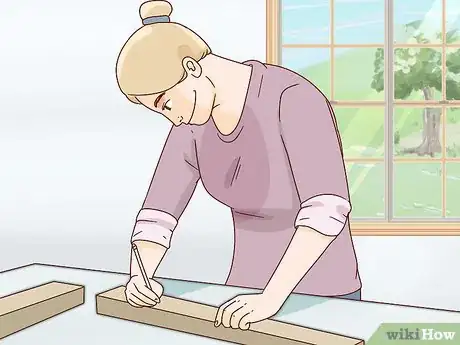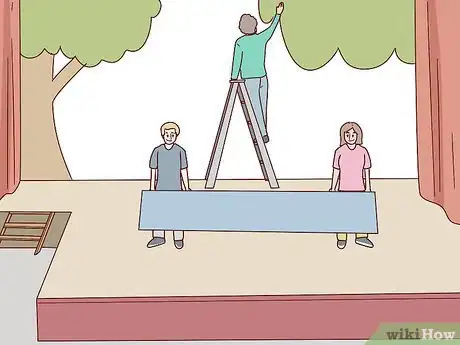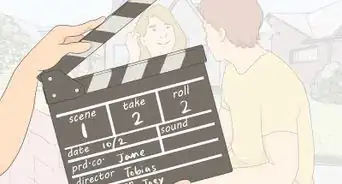This article was co-authored by wikiHow Staff. Our trained team of editors and researchers validate articles for accuracy and comprehensiveness. wikiHow's Content Management Team carefully monitors the work from our editorial staff to ensure that each article is backed by trusted research and meets our high quality standards.
This article has been viewed 91,790 times.
Learn more...
If you love theatre, and the thought of working behind the scenes enthralls you more than the idea of acting onstage, set design may be the perfect job for you. Set designers plan, design, and oversee the construction of sets for theatrical performances, visually conveying the mood, time, and place of the story. Learn the integral art of set design for theatre by working hard to develop your creative design, artistic, technical, and construction skills, as well as by gaining real-world experience in set design.
Steps
Developing the Necessary Creative Design and Artistic Skills
-
1Read books on set design to learn the theory behind it. There are a number of great books available to get you thinking about creative set design ideas. They’ll also provide you with ample inspiration and examples of others’ inventiveness.
- Some books to consider include: Stage Design: A Practical Guide by Gary Thorne, The Backstage Handbook by Paul Carter, What is Scenography? by Pamela Howard, and American Set Design by Arnold Aronson.
- Good set designers are always learning, and they need a wide knowledge base. So read and study about not only set design, but also about art, history, architecture, and interior design, too.
-
2Hone your drawing skills. Drawing is a designer's way of explaining. Talented set designers do not have to have virtuoso drawing skills, but improving your drawing ability helps you both design and present design ideas.
- Read Designing and Drawing for the Theatre by Lynn Pecktal and Drafting for the Theatre by Dennis Dorn and Mark Shanda, which are comprehensive textbooks on how to design and draw sets for the theatre.
- Take drawing classes either online (such as through Udemy), at your high school, or through a local community college or art store.
Advertisement -
3Develop your visual acuity and strengthen your sense of vision. Set design is a highly visual field, so practice always having a keen eye and being aware of and attentive to not only your physical surroundings, but also what’s happening visually in your mental space. Imagination and original innovation are two of the most important qualities that good theatre set designers can have, since the stage you design will only be as interesting as your imagination and ingenuity make it.
- Keep a sketchbook with you wherever you go. Draw both what you see in your mind and what you see around you in your physical surroundings every day.
-
4Take online classes in theatre set design. Some free online courses in theatre set design are available for study on MIT's OpenCourseWare. Take them at http://learningpath.org/articles/Free_Online_Theatre_Design_Courses_from_Top_Universities.html.
- For those who thrive in a more traditional classroom environment, check to see if your high school or nearby colleges offer courses in theatre set design.
Learning the Required Technical and Construction Skills
-
1Take classes in computer-aided design and drafting. While much set design still depends on hand-drawn concepts, computer-aided design and drafting are also taking on a bigger role in set design. [1]
- Enroll in classes in computer aided design and drafting online (for instance, through Udemy) or through your high school or local community college.
-
2Learn basic construction skills in order to construct sets. Set designers not only design sets, but they’re also highly involved in building their own sets. Knowing basic construction skills will also help you better direct carpenters, scenic artists, and prop builders who may work on building your sets.[2] Develop basic carpentry and painting skills, and get a feel for the uses of various different tools and materials.[3]
- Take shop classes at your high school or in your community to learn basic construction skills.
- Read the Stock Scenery Construction Handbook by Bill Raoul and Mike Monsos and Scene Design: A Guide to the Stage by Henning Nelms to learn basic construction and painting skills specific to the stage.
-
3Learn how to create 3-D models. While drawing skills are important, not every director can envision how your drawing will be actualized in 3-D. So models help you and your director better understand how your concept works in scale.[4] You can either build your own models to scale from scratch or purchase pre-made set design model systems online at various websites, such as https://printamodel.com/.
- Two quality books that you can read to learn how to make models for the stage are Model Making for the Stage: A Practical Guide by Keith Orton and The Handbook of Model-making for Set Designers by Colin Winslow.
Gaining Real-World Experience in Set Design
-
1Network and find mentors in theatre set design. Share your projects and project ideas with other designers to receive feedback and better your craft. Connect with other theatre professionals through your local theatres, through social media sites such as LinkedIn, and at conferences which offer theatre professionals the opportunity to network and share their craft.
- Also listen to advice from stage carpenters, painters, and other theatre folk who likely have valuable insights into how to bring your set design ideas to life.
- Theatre is a very small world and is all about who you know and who knows you. Avoid leaving bad impressions because your good reputation is valuable.
-
2Volunteer to work on set design at a theatre. Contact local theatres in your area and ask to speak with theatre directors and/or set designers there. Volunteer to work behind the scenes on their productions.
- You can volunteer to work with high school theatre, community theatre, and/or summer theatre productions designing and building sets.[5]
-
3Gain experience with many kinds of theatrical spaces and show types. Expect to start small, such as by assisting a set designer, working as a set dresser, assisting a prop designer, or helping to build and paint sets. As you prove your reliability and competence in these areas, you can ask for and will likely be given greater responsibilities and more opportunities to grow your skills in set design.
- To work as a set designer with a larger, established theatre company, you will usually need to have experience in lower-level positions and smaller theatres. Some designers begin by working as carpenters, scenic painters, or even as deck hands or "run crew."
-
4Create a portfolio of your best set design work. Never leave a project without making sure you have photos and/or drawings of your work and process to show your next potential client your talent. Always document your set design work.
- While some people may choose to major in theatre or obtain a M.F.A. (Master of Fine Arts) in order to learn the required artistic and technical skills necessary for theatre set design, college degrees are not necessary to excel in set design or to obtain work in the field. Your portfolio, previous work in set design, and who you know will likely be more important than a college degree. [6]
-
5Be proactive and on the lookout for new opportunities in set design. Most jobs will come through your connections and what you prove you can do, but some theatres post job listings online at websites such as https://www.backstage.com/ or on their own websites.
- Summer theatre companies tend to recruit at regional conferences such as the "Southeastern Theatre Conference" (SETC) where they can interview en masse for their summer season. There are also companies, like Disney and Carnival Cruise, at conferences that hire set designers for longer contracts.
Community Q&A
-
QuestionWhat are some online courses I can take for Set Design and Set Building?
 Julie KaylinCommunity AnswerThere is a link in the article where you can find some free online courses in theatre set design and set building that are available for study on MIT's OpenCourseWare.
Julie KaylinCommunity AnswerThere is a link in the article where you can find some free online courses in theatre set design and set building that are available for study on MIT's OpenCourseWare.
References
- ↑ https://bigfuture.collegeboard.org/careers/arts-visualand-performing-set-designers
- ↑ https://bigfuture.collegeboard.org/careers/arts-visualand-performing-set-designers
- ↑ http://www.hcs.harvard.edu/~htag/handbook/?q=node/19#eight
- ↑ http://www.hcs.harvard.edu/~htag/handbook/?q=node/19#fifteen
- ↑ https://bigfuture.collegeboard.org/careers/arts-visualand-performing-set-designers
- ↑ https://bigfuture.collegeboard.org/careers/arts-visualand-performing-set-designers







































































